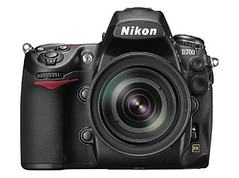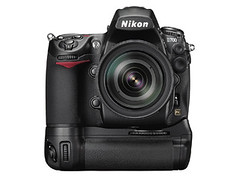Ending many months of speculation, Nikon has announced the existence of the long rumored D700, an FX sensor DSLR in a compact body. Aimed squarely at the Canon 5D, the D700 has several features that surpass the current Canon 5D:


Features
12.1 megapixel FX (full-frame) CMOS sensor with high signal-to-noise ratio, wide dynamic range, and built-in self-cleaning sensor unit that minimizes dust.
ISO 200 – 6400: extendable up to 25600 (equivalent) and down to ISO 100 (equivalent).
5fps continuous shooting (8fps with optional MB-D10 battery pack with lithium-ion battery EN-EL4a or 8 AA batteries).
EXPEED image processing engine with 14-bit A/D conversion and 16-bit image processing for superb detail and tonal gradation.
Advanced Scene Recognition System combines the camera’s metering and AF sensors for precise exposures and sharply defined images.
Multi-CAM3500FX 51-point AF system. Individually selectable or configurable in 9-point, 21-point and 51-point coverage settings.
Picture Controls streamline in-camera image processing by enabling the pre-set customization of image parameters such as sharpening, contrast, brightness, hue and saturation in various color modes.
920,000 dot 3-inch VGA LCD monitor with wide, 170-degree viewing angle.
Live View with Autofocus enables composition of images by use of the LCD monitor. Two modes are supported: Handheld or Tripod.
DX Crop Mode can be automatically enabled when a DX format lens is attached.
Quick response: approx. 40 ms shutter-lag.
Active D-Lighting enables superior high-contrast images by automatically applying tone compensation at the moment of capture.
HDMI video output interface enables connection to high-definition video systems.
Intuitive ergonomics with optimized button placement for fast and comfortable handling.
Durable Magnesium alloy body: moisture and dust resistant.
Wireless LAN and Ethernet support via optional Wireless Transmitter WT-4.
Specifications
| Effective pixels | 12.1 million |
| Image sensor | CMOS sensor, 36.0 x 23.9 mm; total pixels: 12.87 million; Nikon FX format |
| Image size (pixels) | FX format (36 x 24): 4,256 x 2,832 [L], 3,184 x 2,120 [M], 2,128 x 1,416 [S]
DX format (24 x 16): 2,784 x 1,848 [L], 2,080 x 1,384 [M], 1,392 x 920 [S] |
| Sensitivity | ISO 200 to 6400 in steps of 1/3, 1/2, or 1 EV; can be set to approx. 0.3, 0.5, 0.7, or 1 (ISO 100 equivalent) EV below ISO 200, or to approx. 0.3, 0.5, 0.7, 1 (ISO 12800 equivalent), or 2 (ISO 25600 equivalent) EV over ISO 6400 |
| Storage media | CompactFlash (Type I, compliant with UDMA) |
| Monitor | 3-in., approx. 920,000-dot (VGA), 170-degree wide-viewing-angle, 100% frame coverage, low-temperature polysilicon TFT LCD with brightness adjustment |
| Exposure metering | 3D Color Matrix Metering II, Center-Weighted and Spot Metering |
| Exposure modes | Programmed Auto (P) with flexible program, Shutter-Priority Auto (S), Aperture-Priority Auto (A), Manual (M) |
| Interface | Hi-Speed USB |
| Power sources | One Rechargeable Li-ion Battery EN-EL3e, Multi-Power Battery Pack MB-D10 (optional) with one Rechargeable Li-ion Battery EN-EL4a/4/3e, or eight R6/AA-size alkaline (LR6), Ni-MH (HR6), lithium (FR6) batteries, or nickel-manganese (ZR6) batteries |
| Dimensions (W x H x D) | Approx. 147 x 123 x 77 mm (5.8 x 4.8 x 3.0 in.) |
| Weight | Approx. 995 g (2.19 lb.) without battery, memory card, body cap or LCD monitor cover |
 Lens Cap. This clever gadget combines a custom white balance tool with a lens cap. The practical offshoot of this combo is that you have one less bit of kit to have to haul around in your camera bag.
White balance refers to the color of the light being used to illuminate the subject. Even though the light may look white to our eyes, it may have a color cast to it ranging across the entire visible spectrum (and a little bit beyond depending on the camera used). The color of the light is referred to as the color temperature and is expressed as a numeric value in degrees Kelvin.
In the world of film, this is handled by the chemistry of the film used - daylight film for general use, tungsten film for studio lights, IR/UV film for special purposes.
In the digital world, a special sensor in the camera tries to determine the color of the light being used. Modern DSLRs have vastly improved Auto White Balance (AWB) sensors but they are not perfect and can be fooled by mixed lighting environments. Modern DSLRs also provide several preset white balance settings as well as a method to input color temperatures (in degrees Kelvin) directly or to take a custom measurement before shooting.
However, if one is shooting in RAW mode (and you should be), RAW conversion software will allow to make white balance corrections easily afterwards. The only time this does not work is if the target has no white/gray/black on them for the software to get a reading. In this case, one must take a custom white balance reading by using a white/gray card and taking a test shot.
So now we have two schools of thought on this matter:
* Shoot AWB and fix in post.
* Shoot with custom white balance and get it right in the camera (mostly).
On the surface, the "Fix it in post" school of thought seems to be the logical choice except in those cases where there is no white/gray/black to take a reading off of.
Or is it?
Lens Cap. This clever gadget combines a custom white balance tool with a lens cap. The practical offshoot of this combo is that you have one less bit of kit to have to haul around in your camera bag.
White balance refers to the color of the light being used to illuminate the subject. Even though the light may look white to our eyes, it may have a color cast to it ranging across the entire visible spectrum (and a little bit beyond depending on the camera used). The color of the light is referred to as the color temperature and is expressed as a numeric value in degrees Kelvin.
In the world of film, this is handled by the chemistry of the film used - daylight film for general use, tungsten film for studio lights, IR/UV film for special purposes.
In the digital world, a special sensor in the camera tries to determine the color of the light being used. Modern DSLRs have vastly improved Auto White Balance (AWB) sensors but they are not perfect and can be fooled by mixed lighting environments. Modern DSLRs also provide several preset white balance settings as well as a method to input color temperatures (in degrees Kelvin) directly or to take a custom measurement before shooting.
However, if one is shooting in RAW mode (and you should be), RAW conversion software will allow to make white balance corrections easily afterwards. The only time this does not work is if the target has no white/gray/black on them for the software to get a reading. In this case, one must take a custom white balance reading by using a white/gray card and taking a test shot.
So now we have two schools of thought on this matter:
* Shoot AWB and fix in post.
* Shoot with custom white balance and get it right in the camera (mostly).
On the surface, the "Fix it in post" school of thought seems to be the logical choice except in those cases where there is no white/gray/black to take a reading off of.
Or is it?












